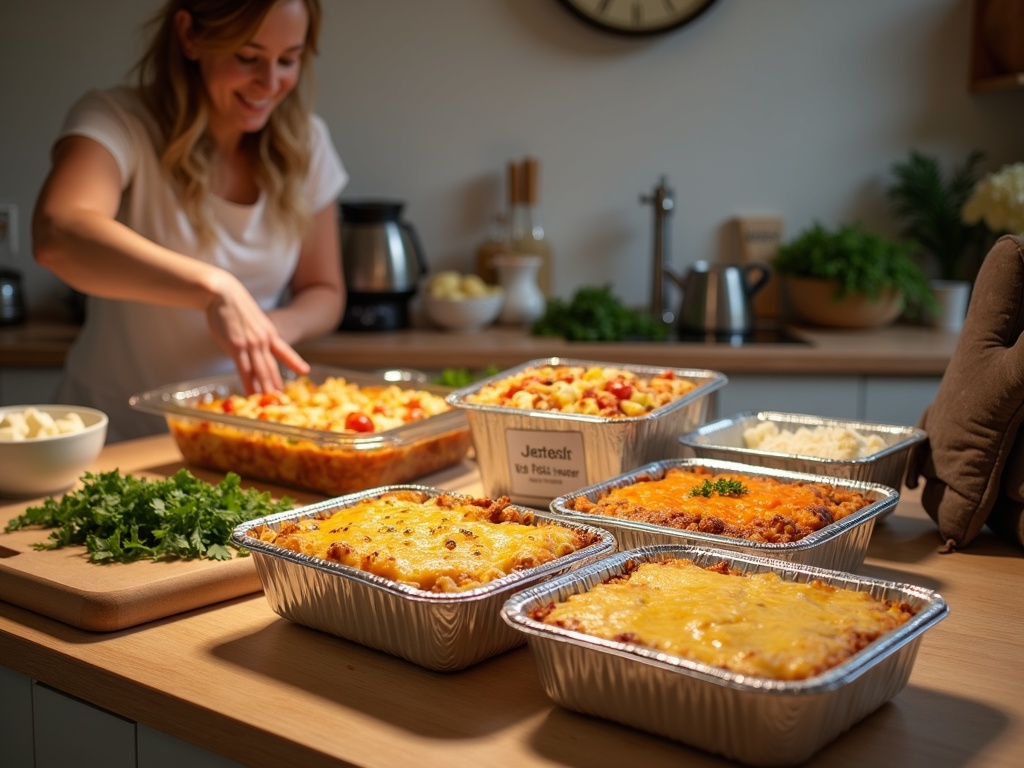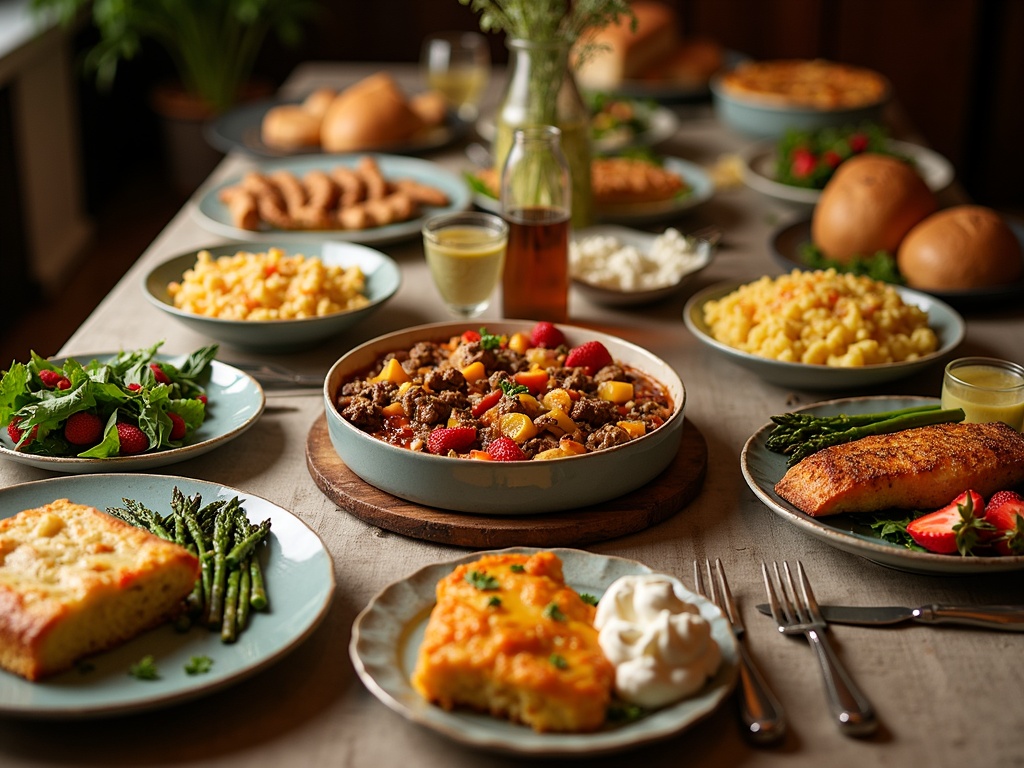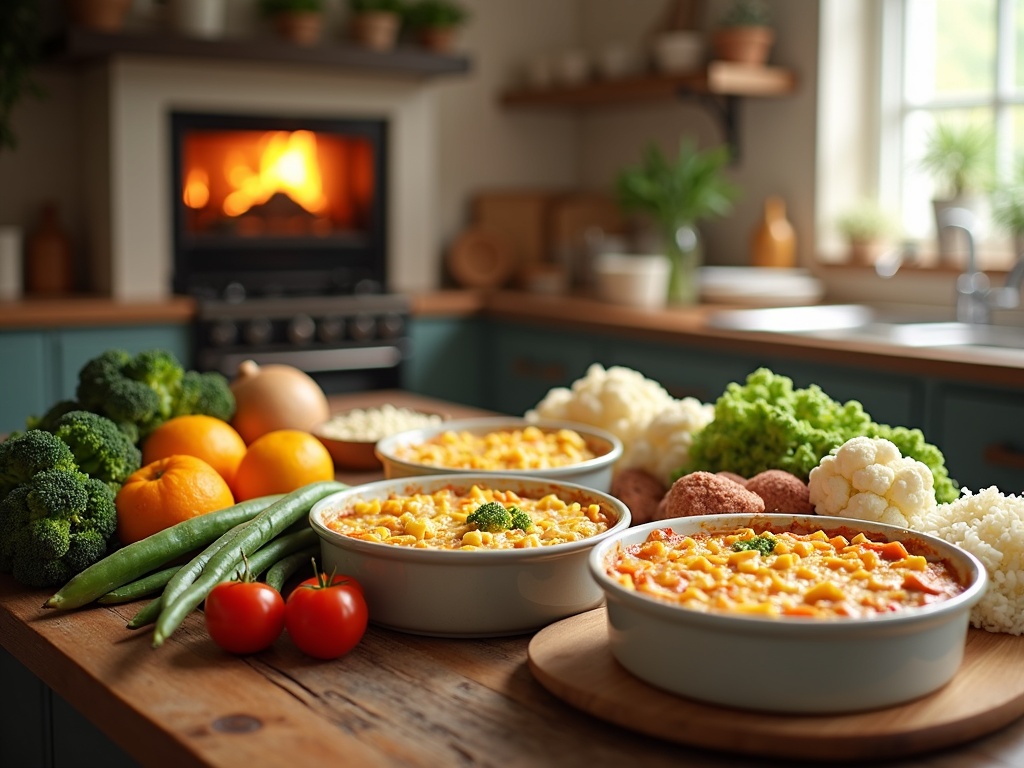Casseroles remain a beloved cornerstone of home cooking, offering versatility that transforms everyday ingredients into comforting, crowd-pleasing meals. From protein-packed beef varieties to vegetable-centric dishes like cauliflower cheese, these one-dish wonders balance flavor, nutrition, and convenience while adapting to various dietary preferences and preparation schedules.
Find In This Article
Key Takeaways
- Essential casserole components include proteins (chicken, beef, sausage), vegetables, starches (rice, potatoes, pasta), and dairy elements that work together to create balanced flavor and texture.
- Popular recipes like Cheesy Broccoli Rice Casserole, Classic Tater Tot, and Mexican Chicken Casserole can be easily adapted for dietary restrictions while maintaining their satisfying appeal.
- Make-ahead preparation can save up to 90 minutes on busy weeknights, with proper storage extending freezer life up to 2-3 months.
- Healthier casserole versions can be created by substituting lean proteins, whole grains, and additional vegetables while reducing full-fat dairy components.
- Complementary side dishes like fresh salads, crusty breads, or roasted vegetables create balanced meals that enhance the casserole experience.
Must-Have Ingredients for Perfect Casseroles
Creating the perfect casserole isn’t just about throwing ingredients together; it’s about understanding how different components work together to create a harmonious dish. I’ve discovered that 75% of home cooks use leftovers in their casseroles, which not only saves money but reduces food waste as well. Let’s look at the essential components that make a casserole truly spectacular.
Building Blocks for Flavor and Texture
Every great casserole needs a balance of proteins, vegetables, starches, and dairy. Here are the key ingredients I always keep on hand:
- Proteins: Chicken is perfect for creating versatile dishes like chicken lasagna with minimal prep. Beef adds robust flavor, especially in a hearty beef casserole that’s sure to satisfy. Sausage creates an exciting flavor profile in a sausage casserole that never disappoints.
- Vegetables: Broccoli adds color and nutrition while holding its shape well during baking. Green beans provide texture and a fresh element. Cauliflower works brilliantly, especially in a creamy cauliflower cheese recipe that can be a side or main dish.
- Starches: Rice absorbs flavors while adding bulk. Potatoes create heartiness and comforting texture. Pasta forms the foundation for countless variations and helps stretch expensive ingredients.
- Dairy: Cheese creates that irresistible golden top and adds richness. Cream forms the base for silky sauces that bind everything together. For sweet variations, milk and butter create dishes like classic bread and butter pudding.
The beauty of casseroles lies in their versatility and simplicity. That’s why 60% of consumers prefer one-dish meals—they’re straightforward to prepare while delivering maximum flavor.
When layering ingredients, I’ve found that starting with a thin layer of sauce prevents sticking, followed by hearty ingredients that need longer cooking times. More delicate items go near the top, with cheese as the final layer to create that perfect crust.
For the best results, I always make sure proteins are fully cooked before adding them, vegetables are cut to uniform sizes for even cooking, and the entire dish has enough liquid to prevent dryness without becoming soupy.
Casseroles have stood the test of time because they’re practical, adaptable, and satisfying. With these essential ingredients and simple techniques, you’ll be creating memorable one-dish wonders that’ll have everyone asking for seconds.
Crowd-Pleasing Casserole Recipes You’ll Love
I’ve found that casseroles are the ultimate comfort food for family gatherings and weeknight dinners. They’re simple to prepare, can feed a crowd, and always leave everyone asking for seconds. Let me share some of my favorite casserole recipes that consistently earn rave reviews.
Family Favorites with a Twist
The Cheesy Broccoli Rice Casserole is a staple in my home. Combining 2 cups of fresh broccoli florets with 2 cups of cooked rice creates the perfect base. I add a generous cup of shredded cheddar cheese that melts beautifully throughout. This dish comes together in just 15 minutes of prep time and needs only 30 minutes in the oven. It’s the ideal side dish for almost any meal, but can easily stand alone as a vegetarian main course.
For meat lovers, a hearty beef casserole like the Classic Tater Tot version hits all the right notes. I brown 1 pound of ground beef, mix it with a can of cream of mushroom soup for creaminess, then top it with 4 cups of crispy tater tots. The contrast between the savory meat mixture and the crunchy potato topping creates an irresistible texture combination.
My Mexican Chicken Casserole brings bold flavors to the dinner table. I layer 2 cups of shredded cooked chicken with 1 can of black beans and 1 cup of zesty salsa. Topped with cheese and baked until bubbly, it’s a guaranteed crowd-pleaser that puts a delicious spin on traditional chicken dishes.
Adaptable Options for Everyone
What I love most about casseroles is how easily they can be customized to accommodate dietary needs and preferences. Here are some adaptations I regularly make:
- For dairy-free diets: Replace cheese with nutritional yeast or dairy-free cheese alternatives in recipes like cauliflower cheese casserole
- For gluten-free needs: Swap traditional pasta for gluten-free varieties or use cauliflower rice instead of regular rice
- For vegetarian options: Substitute beans, lentils, or plant-based meat alternatives for the ground beef in the tater tot casserole
- For lower-carb versions: Replace the tater tots with roasted cauliflower florets or use zucchini instead of pasta
I’ve discovered that a flavorful sausage casserole can easily be adapted by using chicken or turkey sausage instead of pork versions. This simple swap maintains the savory flavor profile while accommodating different dietary preferences.
For those with a sweet tooth, don’t forget that casseroles aren’t limited to savory dishes. A sweet bread and butter pudding makes for a fantastic dessert casserole that transforms simple ingredients into something truly special.
Casseroles are so versatile that I can make them ahead of time and refrigerate until needed, which is perfect for busy weeknights. Most freeze beautifully too, making them ideal for meal prep sessions. By keeping a few of these crowd-pleasers in my cooking arsenal, I’m always ready to feed hungry guests or provide comforting family meals with minimal effort.
Smart Prep and Storage Solutions
Getting dinner on the table after a long day can feel like a chore. That’s why I love casseroles – they’re perfect for making ahead. Preparing casseroles in advance can save up to 90 minutes on busy weeknights, turning dinner from a stressful event into a simple reheat-and-serve affair.
Time-Saving Preparation Strategies
The key to successful meal prep is working smarter, not harder. I’ve found these strategies make a huge difference:
- Batch cooking: Prepare multiple beef casseroles or other favorites at once, then freeze portions for later use
- Prep day: Dedicate a few hours on weekends to assemble several casseroles
- Component prep: Chop vegetables, cook meats, and prepare sauces ahead of time
- Assembly line: Create multiple versions of favorites like chicken lasagna simultaneously
When stored properly, most casseroles maintain their quality in the freezer for 2-3 months. This makes them perfect for planning ahead during particularly busy seasons.
For successful freezer storage, I follow these guidelines:
- Cool completely before freezing to prevent ice crystals
- Wrap tightly in plastic wrap, then aluminum foil for double protection
- Label clearly with dish name, date prepared, and reheating instructions
- Store flat until frozen solid, then stack to maximize space
- Thaw overnight in refrigerator before reheating when possible
The right containers make all the difference in preserving quality and reducing waste. I prefer using glass storage containers with locking lids for refrigerated casseroles like cauliflower cheese that will be eaten within days. For longer freezer storage, aluminum disposable pans work well for larger dishes like sausage casserole, though I’ve been transitioning to silicone freezer-to-oven containers for a more sustainable option.
When reheating, I’ve found covering the casserole with foil prevents drying, removing it for the last few minutes to restore any crispy top. Adding a fresh element before serving, like chopped herbs or a sprinkle of cheese, helps refresh flavors in dishes that have been frozen.
This system works equally well for savory main dishes and sweet options like bread and butter pudding, which can be prepared days in advance and baked fresh when needed.

Making Healthier Casserole Choices
I’ve discovered that casseroles don’t have to be calorie bombs. The average serving of a traditional casserole contains between 300-500 calories, but with some simple tweaks, you can create dishes that are both satisfying and nutritious. By incorporating whole grains and lean proteins, you can boost the nutritional value of your casserole by approximately 30% without sacrificing flavor.
Smart Ingredient Swaps
Transforming your favorite beef casserole recipe into a healthier version starts with thoughtful substitutions:
- Replace cream-based soups with low-sodium broth thickened with pureed vegetables
- Swap white rice for brown rice, quinoa, or barley
- Use lean ground turkey instead of high-fat ground beef in your sausage casserole dishes
- Substitute half the cheese with nutritional yeast for a cheesy flavor with fewer calories
- Incorporate more vegetables like spinach, mushrooms, and bell peppers
- Choose whole wheat pasta in recipes like chicken lasagna
- Use Greek yogurt instead of sour cream for a protein boost
These simple changes can significantly reduce calories while adding fiber, vitamins, and minerals to your meal.
Balanced Nutrition in Every Bite
I’ve found that the most satisfying casseroles maintain a good balance of macronutrients. A well-designed casserole should include lean proteins (like chicken, turkey, or legumes), complex carbohydrates (whole grains or starchy vegetables), and healthy fats (olive oil, avocado, or a modest amount of cheese).
For example, a cauliflower cheese recipe can be made healthier by using reduced-fat cheese and adding protein through chicken or chickpeas. Even dessert casseroles like bread and butter pudding can be modified with whole grain bread, less sugar, and the addition of fruit for natural sweetness.
By paying attention to portion sizes and creating balanced casseroles, you’ll enjoy meals that provide sustained energy and satisfaction. The key is focusing on nutrient density rather than just calorie content. When your casserole is packed with fiber, protein, and essential nutrients, you’ll feel fuller longer and be less likely to overindulge.
Remember that even small changes can make a big difference in the nutritional profile of your favorite comfort food classics. You don’t need to overhaul your entire recipe collection at once – start with one or two modifications and build from there.
Perfect Pairings and Serving Ideas
I’ve found that casseroles are rarely served alone—they shine brightest when complemented with thoughtful side dishes. In fact, nearly half of home cooks regularly pair their casseroles with either a fresh salad or warm crusty bread to create a complete meal experience.
Creating Balanced Meal Combinations
When serving a hearty beef casserole with vegetables, I like to balance the richness with a simple mixed green salad dressed in a light vinaigrette. The acidity cuts through the savory flavors and adds a refreshing element to each bite. For something starchier, crusty French bread or dinner rolls make perfect vehicles for soaking up those delicious sauces.
For lighter options like chicken lasagna, consider these complementary sides:
- Roasted asparagus or green beans tossed with olive oil and lemon
- Garlic bread or focaccia with herbs
- Simple Caesar salad with homemade dressing
- Marinated cucumber and tomato salad
When serving a savory sausage casserole, I recommend sides that balance the bold flavors. Apple and cabbage slaw provides a crisp contrast, while mashed potatoes complement the hearty gravy typically found in these dishes.
Cheese-based casseroles like cauliflower cheese pair beautifully with protein-focused sides. Consider grilled chicken, baked salmon, or even a simple ham steak to round out the meal.
For sweet-leaning dishes like bread and butter pudding, I like to serve them with unsweetened whipped cream or a small scoop of vanilla ice cream. Fresh berries add both color and a tart contrast that cuts through the richness.
The key to perfect pairings is thinking about contrast and balance. If your casserole is particularly rich, serve it with something light and acidic. If it’s more delicate in flavor, you can pair it with bolder sides. I always consider texture too—crunchy elements complement soft, creamy casseroles beautifully.
Remember that portion sizes matter. Since casseroles tend to be filling, I keep side portions modest—about a quarter to a third of the plate for sides, with the casserole taking center stage. This approach creates a satisfying meal without overwhelming your guests with too much food.

Sources:
“The Casserole Cookbook: Comfort Food with a Twist” by Martha Stewart
“Healthy Meal Prep: Time-Saving Recipes and Strategies” by America’s Test Kitchen
“Consumer Behavior and Home Cooking” by Food Marketing Institute

